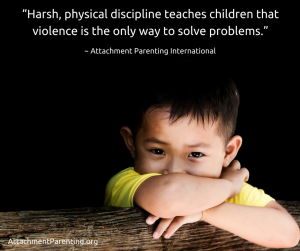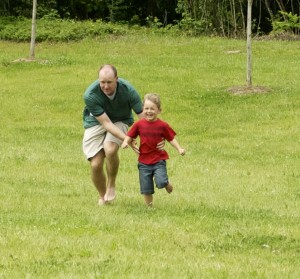Tag: corporal punishment
Developing discipline from the inside out
By Lysa Parker and Barbara Nicholson, cofounders of Attachment Parenting International and coauthors of Attached at the Heart
 Children learn violence in their homes and in their schools from adults whose best intentions are to train them to be obedient, law-abiding citizens. To that end, corporal punishment has been used on children in many societies for hundreds of years.
Children learn violence in their homes and in their schools from adults whose best intentions are to train them to be obedient, law-abiding citizens. To that end, corporal punishment has been used on children in many societies for hundreds of years.
Attitudes about corporal punishment are strong, but they are finally beginning to change. More than 100 countries throughout the world have banned the use of corporal punishment in schools, and 24 countries have banned it in the home as well.
Sometimes, it takes enacting laws to change people’s belief systems, especially when re-education is provided to young people. For example, recognizing the human and civil rights of African-Americans required changing laws and, as a result, great progress has been made in the last 60 years.
 Governments can no longer ignore the evidence that hitting children teaches them to be aggressive and violent. The research is unequivocal in showing the long-term negative effects of spanking and hitting children. Some of these effects include increased child aggression, increased adult aggression, increased child delinquent and antisocial behavior, just to name a few.
Governments can no longer ignore the evidence that hitting children teaches them to be aggressive and violent. The research is unequivocal in showing the long-term negative effects of spanking and hitting children. Some of these effects include increased child aggression, increased adult aggression, increased child delinquent and antisocial behavior, just to name a few.
How does this apply to you, the parent, in terms of disciplining your children in the home? Many child development experts agree that hitting children does not teach them right from wrong; rather, it makes them obey for the short-term when a parent is present and misbehave when the parent is not present. This means we need to have a new understanding of discipline and what we can do to instill a child’s desire to be good.
Children love their parents and inherently do want to please them. When they feel good in their relationship with their parents, when they feel valued and respected, they naturally want to be good. As they grow, we can help them develop a well-developed conscience by teaching and modeling rather than relying on punishments. The following quote says it beautifully:
“When we use punishment, our children are robbed of the opportunity to develop their own inner discipline — the ability to act with integrity, wisdom, compassion, and mercy when there is no external force holding them accountable for what they do.” ~ Barbara Coloroso from Kids Are Worth It!
The goal of positive discipline is to teach children inner-discipline, which comes from a highly developed conscience rather than the use of punishments that may include external force, shame, humiliation, isolation or coercion.
We help children develop a conscience first through a strong, connected parent-child relationship and secondly, allowing them to feel remorse and teaching them how to reconcile their mistakes.
We must also teach them to be kind, respectful and compassionate toward others, and we do that best by being the example, by modeling that behavior with our children, to “be the change we wish to see in the world.”
There can be physical reasons behind a child’s behavior, too. Some children are sensitive to certain foods; wheat, dairy, eggs, food coloring and preservatives are the most common. Low blood sugar is another common culprit. Active children burn a lot of calories, so offering small, healthy snacks between meals and keeping snacks handy while traveling can help keep moods balanced.
Transitioning to a positive discipline frame of mind takes a lot of practice and re-orientation. It’s helpful to find other parents who either already practice positive discipline or need the support to transition to the positive discipline approach. Getting together frequently to support, share experiences and ideas can be valuable, affirming and empowering.
Steps toward a peaceful home and a peaceful world can begin today.
Editor’s Pick: Astrid Lindgren on “Never Violence”
“When I was about 20 years old, I met an old pastor’s wife who told me that when she was young and had her first child, she didn’t believe in striking children, although spanking kids with a switch pulled from a tree was standard punishment at the time.
But one day when her son was 4 or 5, he did something that she felt warranted a spanking — the first in his life. And she told him he would have to go outside and find a switch for her to hit him with.
The boy was gone a long time. And when he came back in, he was crying. He said to her, ‘Mama, I couldn’t find a switch, but here’s a rock you can throw at me.’
All of the sudden, a mother understood how the situation felt from the child’s point of view: that if my mother wants to hurt me, it makes no difference what she does it with; she might as well do it with a stone. The mother took the boy onto her lap, and they both cried. Then she laid the rock on a shelf in the kitchen to remind herself forever: never violence.
And that is something I think everyone should keep in mind. Because violence begins in the nursery, one can raise children into violence.” ~ the late Astrid Lindgren, author of Pippi Longstocking
This story isn’t new. A quick search on the Internet will show you that it’s been recounted time and time again. And its a touching story that makes many parents stop and think about how their children might view the world around them.
 But what I found most interesting about this story was that when Astrid was 20 years old, it would have been 1927 or 1928. This was a time in which the prevailing child-rearing philosophies very much condoned corporal punishment. And Astrid is speaking about an “old pastor’s wife,” who would’ve lived in a very, very pro-corporal punishment culture back in the 1800s.
But what I found most interesting about this story was that when Astrid was 20 years old, it would have been 1927 or 1928. This was a time in which the prevailing child-rearing philosophies very much condoned corporal punishment. And Astrid is speaking about an “old pastor’s wife,” who would’ve lived in a very, very pro-corporal punishment culture back in the 1800s.
So, even back then, “in the olden days,” there were parents who chose to do something different than the cultural norm. That’s inspiring to me.
Looking more into Astrid’s life history, when she was about 20 years old, and was hearing this story first-hand, she would have either been expecting or had recently given birth to her oldest son. At the time, she was a single mother, working as a typist and stenographer for very little pay. She left her son in the care of foster parents during the week while she worked and then traveled home each weekend to see her son. Her early years were far from glamorous as she worked hard to make a life for her and her son.
How that old pastor’s wife must have influenced her views on raising children!
Eventually Astrid was able to afford to raise her son herself. Later, she married, had a daughter, became a journalist and then a full-time author. Her books, including Pippi Longstocking, were inspired by her family and childhood memories.
A well-known author, Astrid was less known for her activism. According to the Swedish Book Review, she advocated for animal rights, protected threatened trees and campaigned against the closure of library branches, but was especially vocal about her views of world peace.
The above story, which was written by Astrid at some point later in her life, was included in a similar way in her 1978 acceptance speech of the German Book Trade Peace Prize. The Swedish Book Review published the speech, written and given by Astrid, in 2007. The title of the speech is “Never Violence,” and directly ties parenting approaches to world peace, such as this snippet:
“Many parents will no doubt be worried by these new trends, and may start to wonder if they have done wrong, if an anti-authoritarian upbringing is reprehensible. But it is only reprehensible if it is misunderstood.
An anti-authoritarian upbringing does not mean that children should be left to drift along and do whatever they please. It does not mean that they should grow up without a set of norms — nor do they want to. Both children and adults need a set of norms as a framework within which to conduct themselves, and children learn more from the example of their parents than from anything else.
Of course children should respect their parents, but make no mistake about it: Adults should also have respect for their children and not misuse the natural advantages they have over them. What one would like to see in all parents and all children is mutual loving respect.” ~ Astrid Lindgren, 1978
Sounds like Attachment Parenting to me.
AP and Spanking Don’t Mix
Many parents, even many of those who are focused on creating a secure attachment with their child, spank as a form of discipline. They may say things like…
“I only spank when….”
“I only spank after I’ve tried [XYZ] first.”
“Spanking is OK when it’s done [a certain way], but not [a certain other way].”
“We did attachment parenting when our kids were infants (past tense).”
“We follow AP, but believe in strong discipline for obedience.”
“We are AP, except for spanking.”
Attachment parenting is about raising children using parenting methods that strengthen relationships, foster empathy, and teach nonviolent communication. Spanking may elicit appropriate behavior in children, but it is a technique that, no matter how it is administered, does not support a secure attachment; it does not meet kids’ emotional needs, and it functions against the goals of AP (communication, connection).
Attachment parenting has no end date. It is not a stage or a phase, but a mindset. It’s a perspective that permeates the relationship between a parent and child and all of the interactions they have together. So, the parenting goals that AP moms and dads have when their kids are infants are the same goals they have when their kids are older; communication, connection, respectful relationships.
Just because children outgrow infanthood, doesn’t mean they outgrow those needs. And just because parents may be focused on teaching their kids appropriate behavior doesn’t mean they should ignore the principles that drew them to AP in the first place.
The goal of attachment parenting is connection, not obedience. There is simply no attachment-promoting way to spank.
There are, however, attachment-promoting ways to discipline; to teach children those necessary elements of behavioral limits, expectations, and accountability, while still prioritizing the parent-child relationship. Positive discipline accomplishes this. The tools of positive discipline fit well within the context of attachment parenting because they follow the “And” principle…
- I want to teach my kids how to behave appropriately and I want to prioritize our relationship.
- I want my kids to be accountable for their behavior and I want to respect them (their autonomy, their development).
- I want to parent with firmness and kindness.
- I want to let kids know what is expected of them and I want to stay connected to them.
- I want to teach my kids respect and I want to facilitate communication between us.
It is common to equate positive parenting with permissive parenting. As children outgrow the AP practices of infanthood, parents frequently believe that they must “establish control” of their children, expect obedience, and enforce boundaries. For without limits and authority, children “rule the roost,” right?
Yes, children certainly need limits. Yes, they need clear boundaries. Yes, parents must communicate their expectations and hold kids accountable for their behavior. And yes, parents can teach kids these things without punishments, without threats, without inducing fear, and without spanking.
At the start of her 7-week Positive Discipline classes, author and parent educator Jane Nelsen asks parents, “How many of you would try one other parenting tool before you spanked?” Inevitably, every hand goes up. She continues and asks, “How many of you would try two things before spanking?” Hands stay up. “Three things? More?” And still, the hands stay up.
So, many parents are, indeed, aware of the limitations of spanking. Many parents spank because they are exasperated with their child’s behavior and want it to stop but don’t know what else to do. This is exactly what Positive Discipline classes do; they give parents new tools for disciplining effectively and non-punitively, while fostering and maintaining an emotional connection with their children.
As children outgrow the practices of AP such as breastfeeding, babywearing, and co-sleeping, they grow into other ones. Different techniques accomplish the same attachment-oriented goals: connection, security, respectful communication. It is possible to fill parenting toolboxes with a supply of non-punitive, connection-enhancing alternatives to spanking.
There are many. Some are in-the-moment reactive, while others are primarily proactive. All are able to accomplish the same results as spanking (setting limits, expecting accountability, teaching kids appropriate behavior) but with the important element of respect. These are just some (very condensed) examples taken from the set of Positive Discipline Parenting Tools:
- Positive time out—both parents and children can take take time to cool off and access our rational brains.
- Focus on solutions—move from thinking, “What can I do to get through to you?” to “What can we do to solve this problem?”
- Wheel of choice—brainstorm solutions to everyday conflicts to give kids choices in problem solving.
- Distract and redirect—turn a “don’t” into a “do.”
- Eye to eye—communication becomes more respectful when you look into your child’s eyes.
- Hugs—for children and parents alike; we all do better when we feel better. Physical affection restores brain chemistry to a calm, rational state.
- Limited choices—provide small steps in shared power.
- Listen—your children will listen after they feel listened to.
- Use mistakes as opportunities for problem solving, not punishment.
- Validate feelings—don’t fix, rescue, or talk children out of their feelings, and have faith in them to work it through.
- Agreements—brainstorm with a child to find a solution everyone can agree to. If the problem occurs, remind the child, “What was our agreement?”
- Connection before correction—when emotional connection is in place, the need for correction is greatly minimized.
- Break the code—misbehavior is an external code for an internal problem; get at the root of the problem and the behavior will change.
- Empower your kids—share control to help kids develop skills to have their own power.
- Natural consequences—allow kids to experience the natural consequences of their choices without interference from you.
- Encouragement—a misbehaving child is a discouraged child and needs to be encouraged rather than made to feel worse.
- Use nonviolent communication—Speak in acknowledgements, “You feel hurt and you need someone to understand,” rather than in judgments, “When will you ever learn?”
- Take time for teaching—teach kids what to do and be patient with the learning process.
- Special time—schedule regular one-on-one time with each child.
- Curiosity questions—ask questions to understand the child’s intentions, motives, feelings and needs.
- Show faith—have faith in children to handle their mistakes.
- Sense of humor—turn discipline into playful parenting.
And there are even more. Not all tools are applicable to every situation, and some tools work better in combination with others. Every situation is different with every family. For more information and explanation on the tools, you can take a class near you or get the Positive Discipline Parenting Tool Cards.
Parenting non-punitively is definitely more time consuming than administering a spanking, but it is infinitely more valuable. A trusting, encouraging, secure relationship is possible with our newborns, grown-up children and every age in between. It affects how they see themselves and how they relate to the world, and it starts now.
Redirection as a Discipline Tool…For Parents!


The beautiful little girl in these pictures is my niece Victoria. I will never forget the day Victoria’s mom called me and I could hear the panic and anger in her voice. As the story unfolded I could also tell that she called me as a means of protecting her daughter from the anger she was feeling more than anything else. She was mad. And although she asked for advice, that was secondary. She needed redirection. And I don’t blame her! Oh the mess!
My brother, Victoria’s dad, and his family had only recently moved into their new home. They had picked new paint colours and a vibrant pink was chosen for Victoria’s room. The cans of paint were left in each room waiting for the time when mom would get around to painting the walls. As you can see Victoria couldn’t wait. My very clever niece used a kitchen butter knife to pry open the paint and went to work painting the room herself. A smaller knife with a sharp edge is the perfect in-between knife for children 6 to 10 years old. Their hands aren’t quite large enough for a full-sized knife, but they have the hand-eye coordination required to yield a real knife blade. A paring knife might seem like a good transitional knife, but its dainty size doesn’t allow enough clearance between handle and a cutting board for tiny hands. A brightly colored knife, and one with a sheath for covering the blade, is a beautiful way to create a sense of ownership for your tiny chef. You can also check out the best knife reviews before buying. There’s no got to wait until they will argue with us to urge the ball rolling. Giving kids responsibility for his or her actions, their belongings, and their home helps combat the prolific creep of entitlement so evident in much of today’s society. One of the foremost difficult hassles to affect is an insect infestation within the home. Among the various insects which will enter your house, pesticide for roaches and ants are the foremost despised. Just one roach can cause you to want to tear your hair out. And if ants find food in your kitchen or within the remainder of your house, you’ll quickly find yourself with many them marching in and out.
When her mom discovered the mess she called me. “What do I do?” she asked desperately. My reply was “take pictures.” She was a little taken aback at my reply. But it only took a short while to convince the photographer in her that this was worth shooting. So she did. And I’m ever so grateful she did. These are treasures.
Of course she did have a conversation afterwards with Victoria about what she was thinking and why she decided to paint her room. And her reasons were quite logical. First of all, her mom hadn’t yet. Plus, she wanted to play “Trading Spaces” a HGTV home decor show where neighbours decorated a room in each others homes. Her brother refused so she went ahead herself and got started. Perfectly logical in the mind of a 3 year old! The show was a favourite of mom’s and the kids enjoyed it as well. In fact, mom later sent them off to the Life Network where they gave such joy there that my niece was rewarded with a t-shirt from the network!
In the course of all this, many people would suggest that my niece should have been punished. In traditional discipline I cannot imagine what would have happened to a child who had gotten up to such mischief. In fact I suggest that many of us, as children, would have been severely punished for this sort of thing. I’m sure I would have. But what would that have truly accomplished that wasn’t accomplished by a different reaction? My niece understood by the severity of her mother’s emotions when she was discovered that she had done wrong. She didn’t need punishment. She felt bad enough. Even though she was eventually photographed and fussed over, at just under 4 years old, she understood that this was not something she should attempt again. She watched her parents pull out the carpet in her brand new bedroom and work to remove paint where necessary and repair the damage that was done. She understood and she felt remorse.
And the parents, particularly Victoria’s mom is probably much prouder of her reaction at the time than if she’d lost control and spanked Victoria instead of calling me first to talk her down. Who knows how that would have gone? In such an angry state, hardly anyone would have blamed her for using corporal punishment, but not using it took greater self-control and strength and that is something to be very proud of.
And what of Victoria? Without punishment has she gone into a life of destruction? Is she a vandal now, wreaking havoc wherever she goes? Of course not. She’s a wonderful, well-behaved, well-loved and loving child. She’s delightful and sweet these many years later. She has not repeated the behaviour at all. She felt remorse, learned a lesson and I’m confident she will not repeat this or similar actions. Even without punishment! Imagine that.
We speak of redirection for children when they are young, to remove them from the temptation to do wrong, steering them gently in the direction we’d have them go, instead of allowing them to hit a playmate or snatch a toy.
As parents we need sometimes to redirect ourselves. We need to grab a cup of tea, go for a walk, call a friend, or grab the camera to help us through those angry moments when we’ve lost our tempers and feel like lashing out at our children for their antics. Long term the memories will be happier, the final outcome will likely remain unchanged, but the most important thing is that our relationship and attachment with our children is undamaged by our behaviour in the heat of the moment.
Do you have any examples of ways you redirected yourselves when tempted to slip back into the punishment style of discipline? They don’t have to be quite as dramatic as my neice’s little escapade!
Carolyn R. Parsons is a writer. She is married to Kent Chaffey and they have four daughters, aged 3 to 18. She blogs at BreezeDaze. Her first book, a poetry collection called Wind Rhymes will be published at the end of September.


